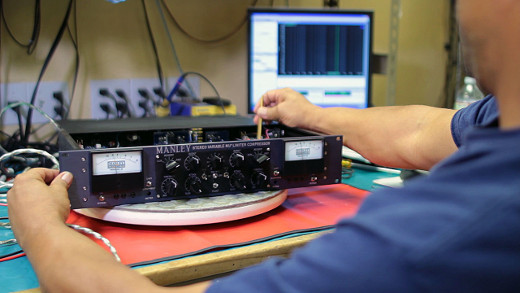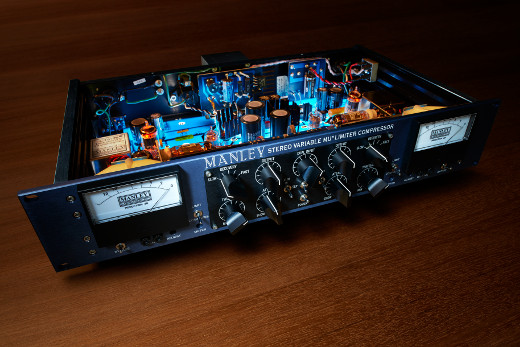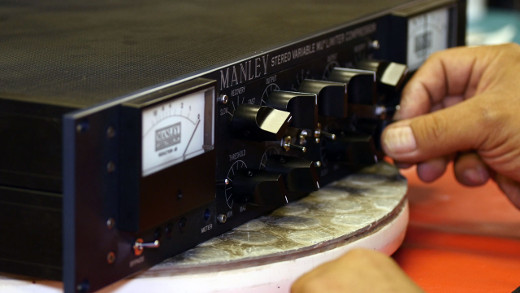How the Emulation Is Made: Universal Audio’s Manley Variable Mu Limiter Compressor Plugin
Adore analog? Dig digital only? Nothing blurs the audio lines like software emulations of hardware processors.
Producers and engineers who are evolving their studios now have an embarrassment of emulations available to them. These are virtual versions of classic and/or rare boxes, and we need them because the real thing — carefully constructed collections of tubes, transistors, and valves – take time to build in the workshop, and their physical numbers are likewise limited.
Quality emulations cost less than the hardware version, and they’re much easier to get. What’s not to like?
Devotees of getting classic sound ITB abound – these digital denizens scour schematics and analyze audio almost endlessly, listening until they create a software clone that sounds and acts like the original unit as much as possible.
One of the most prolific practitioners of the craft is Universal Audio, which currently has 93 plugins available for their UAD Powered Plug-Ins platform and Apollo audio interfaces. Not all of them are emulations, but a growing number are – the Neve 1073 Preamp & EQ Collection, Thermionic Culture Vulture, API Vision Channel Strip, 1176 Limiter, AMS RMX16 Digital Reverb, Lexicon 224 Digital Reverb, EMT 250 Reverb, Roland RE-201 Space Echo, Chandler Limited GAV19T Amplifier, Studer A800, Ampex ATR-102, and Manley Massive Passive EQ, just to name a few.
It was that last one – the Massive Passive – that paved the way for the latest addition to UA’s offerings: the Manley Stereo Variable Mu Limiter Compressor plugin for the UAD Platform and Apollo (which has just bumped up to v7.11). As Manley Labs’ flagship compressor since 1994, the Variable Mu features a Class-A, tube and custom transformer-driven design. It’s highly desired by mixing and mastering engineers who appreciate its smooth, transparent dynamics control, and ability to add clarity and cohesion to stereo buses or an entire mix.
Selling for anywhere between $4,400-6,500 USD, the real thing is no small investment. UA’s version comes in at a much more manageable $299. It’s just a download away, but it carries something heavy duty through your Internets and into your machine: This is a thorough emulation of a legendary tube limiter, based on the “6BA6 T-BAR Tube Mod” unit – a special mod that makes the Variable Mu perform closer to the original (now almost unobtainable) 6386 version.
And there are many yummy aspects to its plugin counterpart, which provides transparent Variable Mu tube compression for master fader, sub-groups, and individual sources. It models the entire stereo Class A circuit, including custom transformers, input gain, and gain reduction characteristics – providing Continuous Dual Input, Stereo Output, Threshold, and Attack controls, as well as Side Chain Filter and L/R or M/S operation.
Sweetening the pot are plug-in only features including Dry/Wet Mix, Controls Linking, and Headroom functions.
What Makes the Cut
Manley Labs President EveAnna Manley and Universal Audio Product Manager Will Shanks both led dedicated teams, who made the Variable Mu emulation move from concept to completion.
According to Shanks, there is a common thread to the hardware that Universal Audio chooses to emulate. “Whether longstanding classics like a Pultec or UA 610, or something fairly recent such as the Empirical Labs FATSO or the Thermionic Culture Vulture, the device usually does ‘that one thing’ that no other processor can do,” he says. “In general, the pro audio audience already really loves, or at least knows the reputation for, the hardware we’re modeling.
“While the Variable Mu uses the remote cut-off style gain reduction found in the Fairchild and other classic limiters, it has a sound and place in the studio very different from a Fairchild, and is considered by many to be a modern classic. The Variable Mu is designed to be dynamically transparent but with an expensive-sounding, high-fidelity finish. There’s nothing else like it.”

The Variable Mu must go through several stages of calibration and measurement during the quality control process.
Past experience with UA on the Massive Passive made it clear to Manley that they should collaborate again on the Variable Mu, although the workflows proved to be different. “The Massive Passive EQ was an easier project to do first, as you don’t have harmonic products changing with level like you do on a compressor/limiter,” she notes. “Universal Audio did an admirable job modelling the Massive Passive, and since then they have tackled more sophisticated projects like the Ocean Way Studios acoustic space emulation, proving they were ready for the Manley Variable Mu.”
Prepping the Partnership
Once Shanks and the rest of the UA team has internally decided on putting an emulation in motion, initiating a partnership with the manufacturer follows. “Whether it begins with an existing connection or a cold-call, we’re already prepared with one or more concepts,” Shanks says of their approach. “Often there is a relationship that is formed over a period of time before deals are made and contracts are signed.
“This is a small industry with a lot of camaraderie, so some of the best partnerships have been birthed from overlapping friendships or business relationships. This may help in the beginning, but our partnerships remain strong throughout the years because of our tireless attention to detail and quality in our plug-in emulations. We work very hard to do the hardware justice, and the one-year development of the Variable Mu was no exception.”
Respect and recognition come to the forefront at that stage. “After all, they created these fantastic designs we are emulating — we always push very hard to involve the hardware manufacturers,” states Shanks. “When it happens, the arrangement rewards them financially for their original design. Of course there’s a powerful brand association we benefit from, but the bottom line is it’s the right thing to do. In general, this approach speaks for itself and not much selling is required: Everyone wins.”
If they haven’t licensed an emulation before, Shanks acknowledges manufacturers may have concerns before diving in. “The biggest worry partners usually have is cannibalization against hardware sales if the target device is still in production. Our approach has shown that hardware sales don’t decline, but conversely sales tend to get an increase when the plugin version is made available. We always encourage potential partners to reach out to existing partners to get feedback on their experience.”
“Cannibalization of hardware sales is always a concern,” Manley adds, “but what we experienced with the Massive Passive plugin was that it seemed to serve as an introduction of sorts to many, many people who would have never encountered the hardware version. And then a certain percentage of those people eventually do buy the hardware. So the plugin serves as very positive advertising.”
Once a licensing deal is in place and a plugin is in development, Shanks begins working on requirements and collaborating on other details like the GUI. Meanwhile UA’s team of algorithm engineers are designing the model, and the partnering manufacturer has already handed over schematics for analysis.
“There may be some collaboration with the partner on some requirements, and we may have questions on design details, which, having access to the designers and originators of the diagrams is a great resource to have,” says Shanks. “We give periodic reports to the partners on the algorithmic implementation progress, but there’s nothing the partner can evaluate at this time. Once a plugin is done, we do extensive listening and signal analysis against the hardware. We look for areas in the model that may have bugs or are not matching quite right sonically. This may involve multiple rounds with the algo engineer before the plugin gets to the partner for evaluation.
“With Manley we get them involved a little earlier than usual, as they are very hands-on and engaged in the evaluation, and want a little more control. They have Audio Precision systems, and thoroughly check frequency and distortion results, compression curves and more.
“They also have trusted users we make the plugin available to early on as well. We work in parallel through this phase on alpha and beta test rounds, and are preparing for the launch.”
Meanwhile on the hardware side Manley credits her husband, mastering engineer Dave Collins, with putting in the most work on both emulation projects. “He spent a lot of time analyzing the measured performance of the plugin versus the hardware, and communicating these empirical differences to the team at UA,” she says. “Once the measurements got really close, Dave was ready to start listening.”
The Processor Process
Every cake bakes individually – UA has seen project development times scale between two weeks (for some algorithmic designs) to over a year. “In general,” Shanks explains, “We make the call when we’ve met all of the sonic and feature requirements, and have pushed the model as far as possible, including all the discovered subtle details and idiosyncrasies found in the hardware.
“Our goal is always no matter where you put the controls, you’ll get the sound and behavior of the target device and be within the hardware’s unit-to-unit variation. Every project is different, with different levels of involvement from partners.
“In most cases they’re thrilled with the sound of the first round available to them. Some may have a few observations which are usually things we’re already aware of and working on. With partners like Manley, they are the designated ‘last lap’ in the sonic sign-off, and are working directly with the design engineer.”

The special “T-Bar Mod” is installed in the Variable Mu. This is the model that Universal Audio chose to emulate.
During the measuring phase, Manley’s group will set goals, and concentrate on certain aspects of the model’s performance that they really want to be right. “These points are what we push the UA coders to make sure to nail,” Manley says. “After comparative listening tests, when the audible differences become quite small, we express our approval to the UA team. These projects take months and months, if not most of a year, for a team of many skilled engineers to complete.”
Emulations That Make It
Naturally, Universal Audio applies some filters to the emulation projects it chooses to pursue. Something that sounds like a great idea at first may soon cause pause.
“Although there has been a gradual increase in sophistication in UA’s modeling techniques over the dozen years we’ve been doing this, there were projects that at the time, we knew we needed to wait on to ensure we could do an excellent rendition of before we released them,” says Shanks. “For instance, modeling well-loved tape machines from input to output was an early concept that sat on the sidelines for many years. We were not interested in doing an abstraction or amalgam of tape behaviors as had been done by others.
“We wanted to provide the experience of the entire signal path: Amplifiers, trim cards, magnetics, various tape media and everything else that made up the sound and behavior of specific tape machine designs — one at a time, in UA’s typical ‘warts and all’ fashion. But this required a lot of front-loaded research to finally arrive at an approach and implementation that met our high internal quality bar. It took a long time, but subsequently we put out our best possible effort.”
When the plugin finally makes it to market, Shanks describes the ideal manufacturer partner. “We can definitely make any partnership work regardless of their level of engagement, from those that are working right alongside us, to those that are happy to just receive their royalty,” he allows. “However, we love when partners like Manley are fully engaged in the sonics, the GUI presentation, the marketing message, the promo video, right down to the user manual! I just got some notes back from EveAnna on that, and I appreciate the care and pride taken in every detail. It’s the same way we approach things.”
— David Weiss
Learn more about the Manley Variable Mu via this vid!

Please note: When you buy products through links on this page, we may earn an affiliate commission.









Russ Hughes
November 21, 2014 at 3:54 am (10 years ago)Good work David.